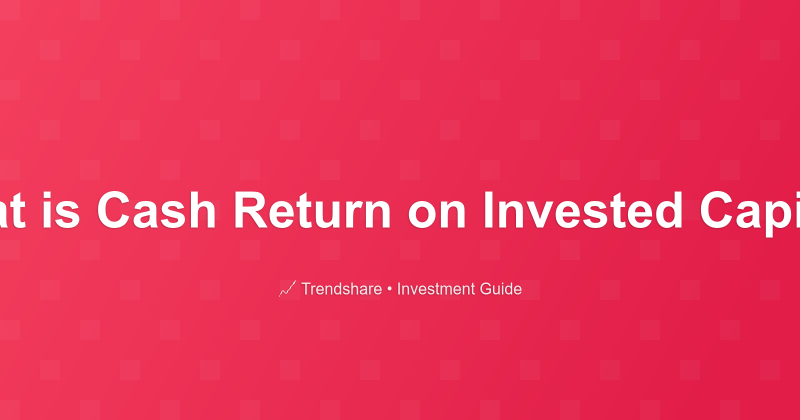
What is Cash Return on Invested Capital?
By Ethan Mercer
Financial Technology Analyst • 10+ years in fintech and payments
How much cash does a business actually generate, compared to the cash actually invested in it? Knowing this will improve your investment returns!
Suppose your cousin comes to you with a great business idea. "It's amazing," he says. "It'll make $2 million in profit every year. That's a cool million for each of us."
That sounds pretty good! A million dollars every year for you for co-owning a business is a good deal. "What's the catch," you ask.
He looks at his feet. "It'll cost us $100 million to get started. But that's a million every year for each of us!"
You probably wouldn't invest in that business, even if you had $100 million to get started. It's too easy to get a better return. It's obvious without even doing the numbers.
What do the numbers say, though?
What is Invested Capital?
What does it cost you to get a business up and running? If you're selling lemonade at the street corner, you need lemons, sugar, water, a pitcher, a sign, and a couple of motivated five year olds who can wave at cars. You won't be breaking the bank.
If you're starting a new airline, you're going to need airplanes, pilot uniforms, baggage trains, desks and gates at airports, and a lot of miniature packets of peanuts and pretzels just to get off the ground.
Sure, even selling a short-haul ticket for $79 gets you more revenue per customer than a $0.50 glass of lemonade, but you had to spend a lot more money to get to the point where you brought in any money at all.
The financial metric invested capital measures the long-term cost of building the company up to its current situation. That's the company's net worth (shareholder equity) plus any long-term liabilities it has. In other words, that's the cost of your lemonade stand, chairs, pitchers, chalk, lemons, water, and little paper cups as well as the cost of your pilot hats, luggage tags, and those big airplanes.
Invested capital is the money it took to build your business.
What is Cash Return?
A good business produces real cash every year. Once you strip away all of the accounting shenanigans, how many dollars do you have piled up in the envelope in the metal box in the lemonade stand?
This cash return is extremely important.
Some people account for this as free cash flow, figuring that it measures money that can be re-invested in the business or returned to owners via dividends or stock buybacks.
You can get more accurate results by calculating owner earnings: essentially net income modified by any changes in working capital and, most importantly, the money the business has to spend to stay in business. You have to rotate the tires of your airplanes once in a while, and that LeMONADe HErE sign won't paint itself, right?
In short, owner earnings reduces the risk that you'll fall prey to some of the accounting shenanigans that companies can play by measuring what the business can actually generate.
Comparing Cash Return to Invested Capital
What happens when you put these numbers together? You get CROIC (or CROCI), the cash return on invested capital.
If your lemonade stand took $100 to build into a business and it generates $100 every month, you have two choices. You could buy $100 dollar-menu tacos and have a party with your coworkers, or you could build a second lemonade stand two blocks away and make $200 the next month, and so on.
If the $100 million you invested in your cousin's idea made you $2 million in a year, you could double the size of the business in only 50 years and walk away with $2 million every year!
In other words, calculating CROIC tells you how efficient a business is at generating money for its owners.
You still have to figure out what's more important: reinvesting in the business or giving that money to its shareholders. Yet CROIC can help you figure out what's a good business and what's a great business. A company with high CROIC (10-13%) is a solid business poised to grow.
Investment Disclaimer
This article is for educational purposes only and does not constitute investment advice. Stock prices, financial metrics, and market conditions change constantly. Company examples are provided for illustration and should not be considered recommendations. Always verify current data from official sources such as company investor relations pages or SEC filings, assess your own risk tolerance and investment objectives, and consult a qualified financial advisor before making investment decisions. Past performance does not guarantee future results.